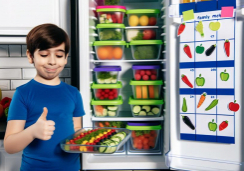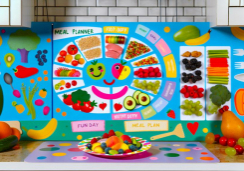Smart Meal Planning for Affordable Family Health
You've probably heard that a trip to the grocery store without a plan is like navigating a jungle without a map—you're bound to get lost among the tempting aisles and emerge with a cart full of items you didn't need.
As a discerning individual keen on safeguarding your family's health without breaking the bank, you understand the importance of smart meal planning. You've mastered the art of dodging budget pitfalls and the siren call of convenience foods, yet there's always more to uncover in the quest for nutritional wealth that doesn't cost the earth.
Crafting a meal plan that's as kind to your wallet as it is to your body requires a blend of know-how and creativity. Stick with me, and you'll discover savvy strategies that empower you to feed your family sumptuous, healthy meals without pouring your savings down the drain.
What's the secret ingredient to striking this delicate balance? Stay tuned, and I'll show you how to elevate your meal planning game to a fine art.
Assessing Your Pantry Basics
Before you plan your next grocery trip, take stock of your pantry to ensure you're fully aware of the staple ingredients you have, which need replenishing, and their expiration dates to maintain a healthy and cost-effective family diet.
Assessing your pantry basics is essential for building a foundation for nutritious meals. It allows you to utilize what you already have, minimizing waste and saving money.
First, identify the pantry staples that are central to many healthy recipes. Items like whole grains, beans, nuts, seeds, and spices not only offer nutritional benefits but also serve as the backbone for diverse and satisfying meals. Take note of any essentials that are running low. Running out of olive oil or quinoa can derail your meal plans, so include them on your shopping list before they're completely depleted.
Additionally, checking expiration dates is crucial. Consuming expired foods can be harmful to your health. Discard anything that's past its prime to ensure the safety of your family's meals.
Crafting a Balanced Meal Plan
Having assessed your pantry and ensured you're well-stocked on essentials, it's time to craft a balanced meal plan that caters to your family's health and budget.
Begin by including a variety of lean protein sources—chicken thighs are both budget-friendly and versatile. You'll want to incorporate them into healthy meals multiple times a week, getting creative with leftovers to maximize their use.
Balance is key, so select nutrient-dense options like new potatoes, rich in potassium, and kale, packed with vitamins A, K, and C. These choices contribute to a meal plan that not only supports your family's health but also excites their taste buds.
Aim for diversity in your meal planning by integrating whole grains and a colorful array of vegetables. Whole grains, such as quinoa or ready-made pouches of brown rice, provide essential fiber and can be the foundation for satisfying dishes. They'll help to keep everyone full and energized throughout the day.
Lastly, consider time and cost-saving strategies, like opting for a frozen fish mix to diversify protein intake without breaking the bank. This approach ensures that you're preparing healthy meals that respect both your family's wellbeing and your budget.
Budget-Friendly Shopping Strategies
How can you stretch your grocery budget while maintaining a nutritious diet for your family?
Start by scouring for specials and sales to stock up on frozen and canned produce, which can often be as nutrient-dense as their fresh counterparts. This strategy allows you to keep costs down while ensuring you have a list of healthy options on hand.
During grocery shopping, use coupons and sign up for store rewards programs to keep track of what's on sale. This proactive approach can lead to significant savings over time. Additionally, buying fresh produce when it's in season is a smart move. Seasonal fruits and vegetables aren't only cheaper but also at their peak in flavor and nutrients.
Avoid the lure of prepared, individually packaged food; these convenient options often come with a higher price tag and added sugars or preservatives. Instead, choose whole fruits that provide natural sugars and essential fiber.
Consider buying food in bulk, which is often less expensive. You can even split the cost with friends or family to make it more manageable.
Implementing these budget-friendly shopping strategies will help ensure your family enjoys a nutritious diet without breaking the bank.
Efficient Meal Prep Techniques
While implementing budget-friendly shopping strategies lays the groundwork for affordable nutrition, mastering efficient meal prep techniques is key to optimizing both your time and health benefits.
You'll find that batch cooking not only saves time but also ensures that you have healthful leftovers at hand. For example, roasting a larger quantity of chicken thighs and accompanying them with cauliflower and squash can provide multiple meals, reducing both cooking time and energy consumption.
Incorporating storecupboard staples into your cooking routine promotes efficiency. A one-pot spaghetti dish with lean beef or turkey meatballs not only cuts down on cleanup but also boosts your family's protein and fiber intake. By prepping whole-wheat rotini pasta ahead of time and preparing a slow cooker pasta e fagioli soup freezer pack, you're setting up for a week of nutritious, fuss-free meals.
Moreover, don't overlook the power of quick-fix meals. Cheese quesadillas with peppers & onions, one-pot spinach, chicken sausage & feta pasta, and an easy chicken enchilada casserole are all time-savers. They allow you to repurpose leftover veggies, ensuring nothing goes to waste while maintaining a focus on nutrient-rich ingredients.
Embrace these techniques and watch as meal prep turns into a manageable, healthful, and cost-effective routine.
How Can Meal Planning Improve Family Health and Save Money?
Smart family meal planning is a simple way to improve overall health and save money. By carefully planning meals, families can make healthier food choices and reduce the temptation to eat out or order takeout. This can lead to significant savings over time, while also promoting a healthier lifestyle for the entire family.
Creative Leftover Transformations
Transform your mealtime routine by creatively repurposing leftovers, ensuring your family enjoys nutrient-rich dishes without waste or added cost. By reimagining last night's dinner, you can whip up exciting family meals that keep everyone's health in focus.
Here's how you can turn remnants from the fridge into recipes for busy weeknights:
- Sunday's Chicken Makeover: Shred the leftover chicken and toss it with sautéed leeks and cooked brown rice for a protein-packed stir-fry that's quick and healthy.
- Veggie Side Switch-Up: Give roasted cauliflower and squash from your traybake new life as nutritious sides to accompany a one-pan spaghetti, adding fiber and vitamins to your family's Tuesday table.
- Chickpea Refresh: Blend Wednesday's leftover chickpeas into a salad dressed with olive oil and lemon, or tuck them into a wrap for an on-the-go Thursday lunch that's rich in plant-based protein.
- Weekend Frittata Fiesta: Come Saturday, whisk those extra veggies into eggs for a colorful frittata, serving up a veggie-dense breakfast that starts the weekend right.
With these tips, you'll not only save time and money, but you'll also provide your healthy family with balanced nutrition. Remember, the best family meals can come from yesterday's flavors, turned today's treasures.
Frequently Asked Questions
How Do You Feed a Large Family Healthy Meals on a Budget?
You'll save by bulk buying, choosing seasonal selections, and coupon clipping. Prioritize nutrition, focusing on whole foods to ensure your family's health without overspending. Always consider their dietary needs first.
How Do I Make a Healthy Meal Plan on a Budget?
To make a healthy meal plan on a budget, you'll want to focus on ingredient swaps, seasonal produce, and bulk buying to maximize nutrients while keeping costs down.
How Do You Plan a Healthy Family Meal?
You'll plan a healthy family meal by choosing seasonal selections, making smart ingredient swaps, and using healthier cooking methods that lock in nutrients and enhance flavors, all while keeping your family's well-being in mind.
How Do You Plan a Healthy Diet for a Family?
To plan a healthy diet for your family, focus on nutritional priorities, incorporate seasonal selections, and consider allergy considerations. Emphasize nutrient-dense foods and involve your family in the planning for better engagement.
Conclusion
In conclusion, you've got the tools to feed your family healthily without breaking the bank.
By taking stock of your pantry, planning balanced meals, shopping smartly, prepping efficiently, and reinventing leftovers, you're setting the table for nutritional success.
Remember, healthful eating doesn't have to be costly; it's about making informed choices. Keep prioritizing nutrient-rich foods and watch your family's health, and budget, flourish.
You're not just saving money; you're investing in your family's well-being.










